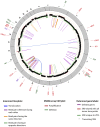Whole-genome sequencing of multiple myeloma from diagnosis to plasma cell leukemia reveals genomic initiating events, evolution, and clonal tides
- PMID: 22529291
- PMCID: PMC3412329
- DOI: 10.1182/blood-2012-01-405977
Whole-genome sequencing of multiple myeloma from diagnosis to plasma cell leukemia reveals genomic initiating events, evolution, and clonal tides
Abstract
The longitudinal evolution of a myeloma genome from diagnosis to plasma cell leukemia has not previously been reported. We used whole-genome sequencing (WGS) on 4 purified tumor samples and patient germline DNA drawn over a 5-year period in a t(4;14) multiple myeloma patient. Tumor samples were acquired at diagnosis, first relapse, second relapse, and end-stage secondary plasma cell leukemia (sPCL). In addition to the t(4;14), all tumor time points also shared 10 common single-nucleotide variants (SNVs) on WGS comprising shared initiating events. Interestingly, we observed genomic sequence variants that waxed and waned with time in progressive tumors, suggesting the presence of multiple independent, yet related, clones at diagnosis that rose and fell in dominance. Five newly acquired SNVs, including truncating mutations of RB1 and ZKSCAN3, were observed only in the final sPCL sample suggesting leukemic transformation events. This longitudinal WGS characterization of the natural history of a high-risk myeloma patient demonstrated tumor heterogeneity at diagnosis with shifting dominance of tumor clones over time and has also identified potential mutations contributing to myelomagenesis as well as transformation from myeloma to overt extramedullary disease such as sPCL.
Figures



Comment in
-
Darwinian evolution and tiding clones in multiple myeloma.Blood. 2012 Aug 2;120(5):927-8. doi: 10.1182/blood-2012-06-430645. Blood. 2012. PMID: 22859708
References
-
- Bergsagel PL, Kuehl WM. Molecular pathogenesis and a consequent classification of multiple myeloma. J Clin Oncol. 2005;23(26):6333–6338. - PubMed
-
- Shaughnessy J, Jr, Gabrea A, Qi Y, et al. Cyclin D3 at 6p21 is dysregulated by recurrent chromosomal translocations to immunoglobulin loci in multiple myeloma. Blood. 2001;98(1):217–223. - PubMed
-
- Chesi M, Nardini E, Lim RS, Smith KD, Kuehl WM, Bergsagel PL. The t(4;14) translocation in myeloma dysregulates both FGFR3 and a novel gene, MMSET, resulting in IgH/MMSET hybrid transcripts. Blood. 1998;92(9):3025–3034. - PubMed
-
- Chesi M, Bergsagel PL, Brents LA, Smith CM, Gerhard DS, Kuehl WM. Dysregulation of cyclin D1 by translocation into an IgH gamma switch region in two multiple myeloma cell lines. Blood. 1996;88(2):674–681. - PubMed
Publication types
MeSH terms
Grants and funding
LinkOut - more resources
Full Text Sources
Other Literature Sources
Medical
Molecular Biology Databases
Miscellaneous

